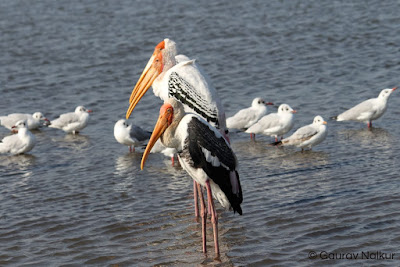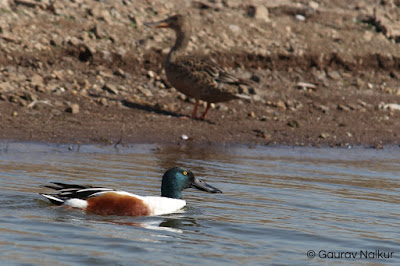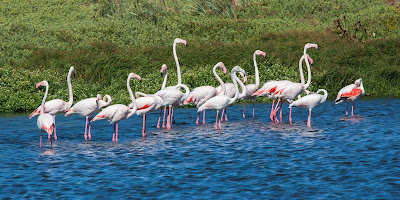I first moved to India in 2003. At the time, my interest in
birding had not developed to the point it has now. It was usually restricted to
watching birds at home, or on the occasional safari holidays my family took
together. In addition, neither did I know any fellow birders, nor did I know
any areas to go birding. Not to mention that I didn’t have my own means of
transport at the time.
My mother and my uncle often told me about this place called
Bhigwan, a 100km or so from Pune, where flamingoes were seen in large numbers
every winter. Budding birder that I was, the word “flamingo” was like a flame
to a moth. The very next winter I begged my uncle to take me there.
At the time, birdwatching at Bhigwan (which I came to know
was just the name of the major settlement there) was a bit of a tricky affair.
You had to find which place near the backwaters was not privately owned, dodge
the landmines of cow and buffalo dung, and watch through binoculars.
Photography was not an option unless you could bribe one of the fishermen to
take you out on the water or had a massive lens. In addition, if you got too
close to the water, there was the risk of sinking into the soft waterlogged
mud. Not that any of that dampened my spirits.
Over the next few years, as I got my driving licence and got
used to Indian traffic, I took my classmates to Bhigwan a few times.
Uncooperative villagers, confusing directions, and the dismal condition of the
road made it a tiresome journey just to see flamingoes from far away.
All that changed in 2011 when a few birding friends of mine
introduced me to Sandip Nagare. Hailing from a small fishing village near
Bhigwan named Kumbhargaon, Sandip and his brother used to take photographers in
their boats to get up close photos of all the birds there. Slowly, Sandip
started building up his business, buying more boats and training more people
from the village.
Starting from only 3 people, Agnipankha now provides
employment for 30 villagers in the area, and now has camping and dining
facilities as well as rooms for overnight stay. Sandip also regularly rescues
birds caught in fishing nets and often talks to the local youth about why birds
are important. The employment he provides and the awareness that he spreads has
led to a reduction in locals killing birds either for fun or for food.
An avid photographer himself as well as having authored
books on Bhigwan’s birds, Sandip today not only provides birdwatchers and
photographers opportunities to see and photograph the beautiful bird life of
the area, but is also important in the local small-scale conservation of this
hotspot.
Bhigwan, or to be precise the backwaters of the Ujjani Dam,
has now become one of my favourite nearby birdwatching destinations. Apart from
the large number of Greater Flamingoes that flock there every winter, the area
also plays host to many other winter visitors, from ducks and waders, to
Demoiselle Cranes, Western Marsh Harriers and Greater Spotted Eagles. The area
also has an amazing diversity of resident birds such as Oriental and Small
Pratincoles, Indian Coursers, Western Osprey, and more.
If you are a birdwatcher and have a few days free in Pune,
Bhigwan is definitely worth a visit in any season!
Phone : +91 8010450000
Email: info@asianadventures.in
https://linktr.ee/aatoursandlodges




No comments:
Post a Comment